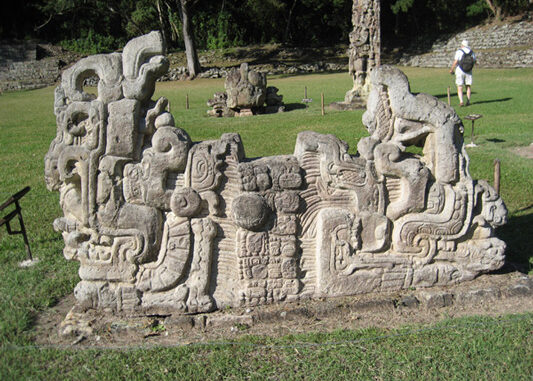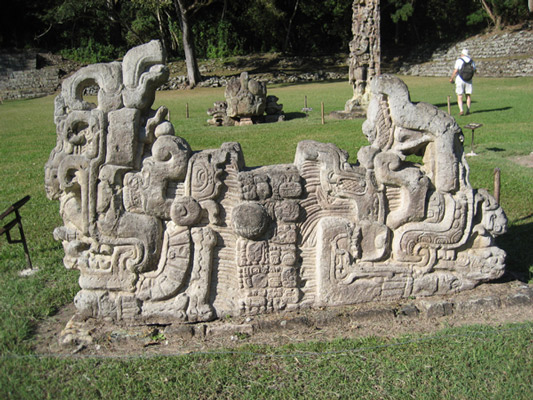

Richard Brommer
Altars and stela of Copán
If you were to hear of kings and rulers with names like Snake Spine, Caspar, Quetzal Jaguar, Anake Jaguar, and Lady Beastie Rabbit , you might think you were hearing about characters in a movie or a video game. But instead, allow these names to conjure up visions of rulers of pre-colonial Mayan dynasties, and of the historic past of Tikal and Copán.
Tikal (in Guatemala) and Copán (in Honduras) are two of the most spectacular sites of Mayan ruins in the world. The Maya flourished for more than five centuries over the area that is now Honduras, Guatemala, Belize, and Mexico. Around 300 a.d., Tikal became an important Mayan center with a peak population of nearly 50,000. Copán’s origins are thought to be somewhere between the fourth and fifth centuries a.d., but some archaeologists believe it to have been some one thousand years before that. At its peak, Copán had a population of a little more than 20,000. Buried in the jungle, the lost cities were not rediscovered until the late 1800s.
Tikal is located in the Petén Basin of northern Guatemala, in the middle of the jungle. The largest excavated Mayan site on the American continent—and considered one of the most spectacular—Tikal became the largest Mayan city-state in Mesoamerica after the downfall of Teotihuacán in Mexico around the year 700 a.d. Tikal’s ruins include more than 3,000 structures, but it’s the tall temples that reach above the rain forest canopy that are the must-see attraction for visitors to the Tikal National Park. From the top of Temple IV, visitors not only take in a fantastic view of the jungle, but can also see the tops of four other temples. On the hike from temple to temple, jungle animals like howler monkeys, toucans, parrots, macaws, and coatimundi are plentiful. In 1979, Tikal was designated as a UNESCO World Heritage site.
Although it is smaller than Tikal, Copán is not only one of the most spectacular treasures of art and architecture in the Americas, but is central to understanding the Maya because of its well-preserved hieroglyphic texts—more than any other Mayan site. Intricate stelae and altars portray the rulers of Copán and describe their power, politics, ideology, and rituals. Archaeologists continue to study these hieroglyphics, and through them have made great progess in deciphering clues about the Mayan culture. No less impressive than the altars and stelae in Copán are the pyramids, temples, and ball court—the second-largest in Central America and considered the most decorative of the Mesoamerican world. Archaeologists know that what we see today in Copán is actually just the tip of the iceburg. Buried beneath these ruins are layers of ruins that predate those that have been unearthed. Since 1999, visitors to the site have been permitted to get a glimpse of these ruins via tunnels.
Archaeologists know that both Tikal and Copán suffered a collapse around 900 a.d., but the reason for their decline remains a topic for speculation. Visitors to the ruins of these enchanting Mayan cities cannot help but wonder why they were abandoned. Follow the link below to see a slideshow of images taken at these important archaeological treasures.
Explore More:
1. Tikal and Copán are on la ruta maya. Can you guess what la ruta maya is? Investigate to learn about it. Then plan a trip along la ruta maya. Create an itinerary, complete with pictures and details about the sites you’ll see on your trip. You may want to design a poster or a PowerPoint® presentation to present your trip to your class.
2. Does archaeology interest you? Have you ever thought about being an archaeologist? Why is it important to investigate past cultures? Do some research to learn about the fascinating work that archaeologists are still doing at Tikal and Copán.
Share What You Know:
1. There are other important sites of Mayan ruins in Mexico and Central America. Can you name any of these?
2. Tikal and Copán have acropolises. Where else in the world is there a famous acropolis?
3. If you are interested in art, you might want to make a drawing or small-scale representation of one of the temples or stelae of Tikal or Copán.